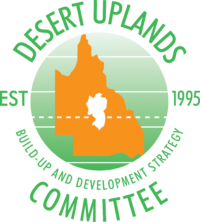The aim of the Landscape Linkages project was to provide a continuous wildlife habitat across the valley joining the Aramac Range to the west and the Great Divide to the east.
Landscape Linkages builds on a research project conducted in 2004-2005 funded by National Action Plan for Salinity and Water (NAPSWQ) to develop a conceptual design for a market based incentive bidding process to deliver landscape connection of good quality biodiversity habitat across the southern Desert Uplands. Landscape Linkages aims to protect remnant vegetation and protect areas of biodiversity significance in the Desert Uplands region. Land within the Linkage will be managed to maintain specified levels of condition and contribute towards biodiversity attributes and improved land condition. The project is being implemented through funding provided by Burdekin Dry Tropics (BDTNRM).

Landscape Linkages has seen the creation of a linkage and protection of biodiversity and conservation values of the southern Desert Uplands region by promoting land management on private land. The result of the project has been 85,000 hectares of privately owned land with ground cover improvements far exceeding those outlined at the commencement of the project. The grass cover for the project area during the two year monitoring period recorded a 40% improvement in the first year and a further 30% increase for the second.
The project highlighted the fact that landholders value the desert country during the extremely dry times as an emergency backup paddock, but perhaps hadn’t been able to see it as having an economic return. Landscape Linkages has provided landholders with the opportunity to put some value on what might otherwise be considered unproductive land from an economic or agricultural perspective. The Box, Ironbark and Yellowjack country, synonymous with the southern Desert Uplands region, has a lot of conservation values and a market to actually be able to provide an economic return.
Feedback from landholders involved in this pilot project was very positive. It reinforced the concept that land can be provided for wildlife and can be a component of grazing management on properties. The Landscape Linkages project puts a value to a part or whole-of-property and as a complete property plan will help with future plans by combining conservation and production needs.
Across Australia as Natural Capital and Biodiversity Stewardship now gains traction, the Landscape Linkages Project shows how, nearly twenty years ahead of this broader adoption, the Desert Uplands Committee investigated and trialled progressive and innovative approaches to a holistic management and valuing of its ecological riches beyond livestock grazing.
